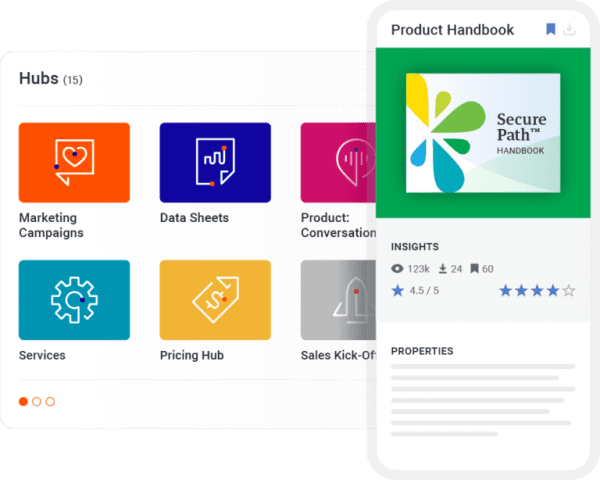Nearly three decades ago, Bill Gates penned a famous article about how “content is king.” Today, this sentiment still rings true – especially in the world of sales.
Sales enablement content is a key ingredient for sales success. When it’s done right, sales content can help sales organizations improve team performance, engage buyers, and ultimately, close more deals.
However not all sales enablement content is created equal. While some sales enablement content is frequently used and proven to move deals forward, other content ends up sitting on the shelf unused.
A solid sales enablement content strategy ensures you have more of that first kind of sales enablement content.
In this article, we’ll explore what sales enablement content is and the types of sales enablement content commonly used by sales teams. We’ll also share tips and tools for creating an effective sales enablement strategy that’ll help your sales teams confidently take on any deal that comes their way.
What is sales enablement content?
Sales enablement content is a powerful asset for new and veteran sellers alike. When sales reps have the right sales enablement content, they’re better able to attract, engage, and convert buyers.
But what is sales enablement content? Essentially, sales enablement content is any content asset developed to help a sales rep succeed in the field.
Some sales enablement content is developed for internal use. Typically, the goal of this content is to provide education to sellers. For example, some organizations create sales battlecards to help sales reps understand how they stack up against their competitors. Often, these sales battlecards are for internal use only.
Other sales enablement content is for external use. Members of the revenue team can share this sales enablement content with prospects as a way to convey or reinforce information about their products or services.
For example, a sales rep might share a case study with a prospect to help them understand how a similar company overcame challenges by using a specific product or service.
What are some sales enablement content examples?
There are many different types of sales enablement content used by sales teams. Let’s take a closer look at some common sales enablement content examples.
Scripts
Often, sales organizations provide scripts to help sales reps scale their outreach while ensuring they stay on message. The organization may develop call scripts – including those that can be used for cold calls and demos. In addition, organizations may equip their sales reps with email templates that they can use as a starting point for their digital outreach.
Competitive battlecards
Per Semrush, 57% of all sales deals are competitive. That number is even higher in certain industries.
Sales battlecards are a type of sales enablement content that helps sales reps understand how their solutions slack up against that of their competitors. Some sales battlecards compare a company’s offerings to a single competitor. Other sales battlecards compare a company’s solutions to multiple competitors. In addition, some sales battlecards are for internal use only, while others are developed to be shared with prospects.
Enablement collateral
Often, teams create a variety of sales enablement content that sales reps can share with prospects throughout the sales cycle. Those assets might include sales presentations, one-pagers providing an overview of specific product offerings, ebooks, and case studies – among others.
Marketing collateral
Some marketing teams develop assets including ebooks and whitepapers. Typically, these assets are developed to educate prospects on a specific industry issue or challenge; they’re not usually promotional. Ebooks and whitepapers can be great resources to share with prospects to demonstrate thought leadership and bolster trust.
Case studies and testimonials
Case studies are a common type of external sales enablement content. Case studies tell the story of how your solution has helped other companies solve their challenges. Case studies provide social proof – which can be a powerful motivator for buyers. They are especially effective for prospects who are further along in the funnel.
Videos
Videos are a more interactive form of sales enablement content. Videos can be internal. For example, the sales enablement team may create a video series to educate sellers on a new product. Or, videos can be customer-facing. For example, the marketing team may develop a demo video for sales reps to share with prospects.
What is a sales enablement content strategy and why is it important?
All too often, organizations develop content that they think will help sales reps – and then hope for the best. The result is that teams spend valuable time creating these resources, but they end up sitting unused. In addition, new sales enablement content is created on an ad hoc basis.
It’s not surprising that this approach isn’t effective.
Instead, organizations need a sales enablement content strategy. But what is a sales enablement content strategy? And what are some sales enablement strategy examples?
A sales enablement content strategy is the foundation for success with sales enablement content. It ensures all stakeholders (including sales, marketing, sales enablement, customer success, and product – among others) are aligned on the organization’s content initiatives.
A documented sales content strategy spells out:
- What your goals are for your sales enablement content
- Who the audience is for your sales enablement content
- What types of content you’ll create to achieve your goals (including the sales enablement content examples we outlined earlier)
- How you’ll measure the success (or failure) of your sales enablement content
A solid sales enablement content strategy can help boost seller performance. A great sales enablement strategy helps ensure sellers have the information, knowledge, and resources they need. That means they’re more likely to be successful in the field.
In addition, a sales strategy can help improve the sales process. Today’s buyers do plenty of research before reaching out to a buyer. A sales enablement strategy ensures sellers can share content that adds value and goes beyond the basic information buyers can easily uncover on their own.
How to create a sales enablement content strategy
Creating a great sales enablement content strategy can boost seller performance and improve customer experiences. But creating a sales enablement content strategy can seem overwhelming, especially if you’re used to a more random approach to sales enablement content development.
Creating a sales content strategy doesn’t have to be a daunting process. Here are some proven tips you can use to make the process easier.
Your sales reps are meeting with prospects all day long. Ask them for feedback on what challenges they regularly face in the field. In addition, ask them what types of content they typically use – and what additional types of content they think would be helpful. You may also want to ask them why they don’t use certain sales enablement content assets.
Take inventory of your sales enablement content. If you use a sales content management platform, this should be relatively easy.
Your inventory should include both internal and external content. Make a note of which content is in need of updates – and which should be eliminated completely.
In addition, tap into data to see what content is being used, how often it’s being used, and whether it’s improving outcomes. Your sales content management platform should provide data, analytics, and dashboards that shed light on usage and effectiveness of your existing sales enablement content.
Different sales enablement content is effective at different stages in the buying process. For example, a thought leadership piece like an ebook or a whitepaper is a great asset for prospects early on the purchase journey. A case study, on the other hand, is more likely to resonate further down in the funnel.
Be sure to map your customer journey. Then, identify which existing sales enablement content fits into each stage.
Once you’ve gotten feedback from your sales team, taken an inventory of your existing sales enablement content, and mapped that content to your customer journey, you should have a good idea of where there are gaps.
Once you’ve identified gaps in your sales enablement content, it’s time to create content to fill those gaps. This should be a collaborative effort among teams including sales, marketing, and sales enablement.
In some cases, sales enablement content is distributed through email. Other sales organizations use a service like Google Drive or Dropbox to store and distribute sales enablement content.
These approaches make it hard for sellers to find the content they need. What’s more, your sellers are likely using outdated sales enablement content.
A better approach is to store your sales enablement content in a complete revenue productivity platform that incorporates sales enablement content management capabilities. That way, sales reps can easily find the content they’re looking for – any time and from any device. The right sales content management platform also helps ensure sellers are always using the most up-to-date sales enablement content.
Developing great sales enablement content is important. But so too is ensuring your sellers know it exists – and how to use it. Be sure to provide sales enablement, training, and coaching so your sellers know how to effectively use the sales enablement content that is available to them.
It’s important to measure the performance of your sales enablement content on a regular basis. That way, you know whether your sales enablement content is helping you achieve your goals.
Ongoing measurement can shed light on opportunities to eliminate content, create new content, and update existing content to improve efficacy.
Developing a sales enablement content strategy isn’t a one-time event. Instead, you should regularly revisit your strategy to ensure it keeps up with the evolving needs and goals of your business.
Take your sales enablement content strategy to the next level with Mindtickle
Great sales enablement content helps sellers confidently navigate every deal that comes their way. A solid sales enablement strategy is foundational.
But creating a sales enablement content is just the first step. Sales organizations must also ensure their sellers know what sales enablement content is available, where to find it, and how to use it.

Mindtickle’s sales enablement content management capabilities allow reps to quickly and easily find the right content for each sales scenario. In addition, sales enablement teams can deliver training and enablement to ensure sales reps know how to use the content that’s available to them. Finally, sales leaders can measure the effectiveness of each sales enablement content asset. They can see whether the asset is being used – and whether it’s improving seller performance and deal outcomes. These insights can help ensure organizations prioritize their time on sales content that’s proven to work.
Sales Content Management in Mindtickle
Ready to see how Mindtickle can equip your sellers with the sales content, training, and insights they need to close more deals?
Request a Demo






